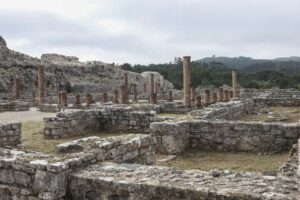 Child burials and pre-Roman wall discovered in Conimbriga
Child burials and pre-Roman wall discovered in Conimbriga
Child burials and pre-Roman wall discovered in Conimbriga
Excavations to support a conservation project for the wall of Conimbriga revealed some surprises, including part of a pre-Roman wall and child burials, a rarity.
In early March, four excavations were carried out next to the Roman wall that delimits Conimbriga in the municipality of Condeixa-a-Nova, in order to diagnose locations for drainage wells in a stabilization project of the site.
One of the sites revealed a section of an Iron Age wall preceding the Roman occupation of Conimbriga, confirming its existence for the first time, according to Virgilio Correia, an archaeologist from the Museum of Conimbriga who directed the excavations. Meanwhile, the “greater surprise” came in the form of six child burials from the Roman period that were found at two of the excavation sites. Such burials were “very rare throughout the Empire,” Correia explained, adding that there are only “two or three dozen” known from the Roman period within the Roman Empire’s sphere of influence.
The infants are thought to have been between weeks and less than a year old at the time of their burial. Given the location of their discovery, it is believed that they may have been buried while the area was a kind of construction site for the Roman wall, in which the nearby amphitheatre would have been demolished.
“From a legal point of view, a child was not a person, and therefore there were all kinds of strange practices. There were many that were thrown into a pile of rubble. We weren’t expecting it,” said Correia.
The team also found a small inkwell from the Roman occupation that would have been used for dipping a pen to write. This discovery delighted the team, and the piece may end up being displayed in the museum.
The excavations featured remnants from the 3rd/4th centuries BC up to the medieval period (9th/10th centuries AD), including charred seeds and carbon, which will be studied to identify the site’s diet, fauna, and flora.

